Black Lives Matters - The Breathe Act
VerifiedAdded on 2022/03/21
|8
|1916
|551
AI Summary
In this assignment, we discuss Black Lives Matter - The Breathe Act It will take all Americans to stand up and acknowledge that racial profiling against blacks still occurs if this law is to be successful. The Breathe Act is regarded as a civil rights law that was richly merited, particularly for people of color. The Breathe Act protects black and brown individuals from racial profiling and police abuse while also fostering a sense of community.
Contribute Materials
Your contribution can guide someone’s learning journey. Share your
documents today.
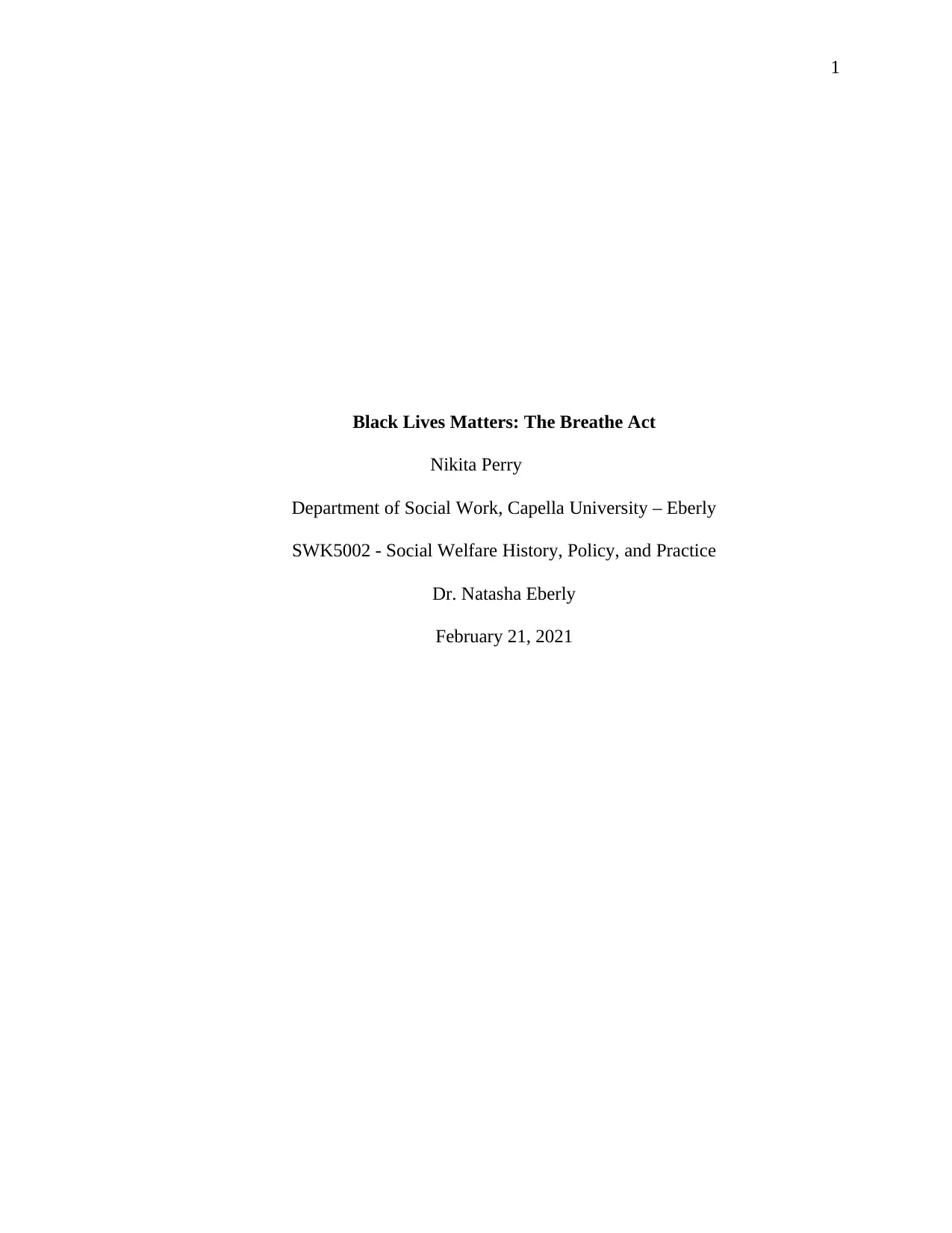
1
Black Lives Matters: The Breathe Act
Nikita Perry
Department of Social Work, Capella University – Eberly
SWK5002 - Social Welfare History, Policy, and Practice
Dr. Natasha Eberly
February 21, 2021
Black Lives Matters: The Breathe Act
Nikita Perry
Department of Social Work, Capella University – Eberly
SWK5002 - Social Welfare History, Policy, and Practice
Dr. Natasha Eberly
February 21, 2021
Secure Best Marks with AI Grader
Need help grading? Try our AI Grader for instant feedback on your assignments.
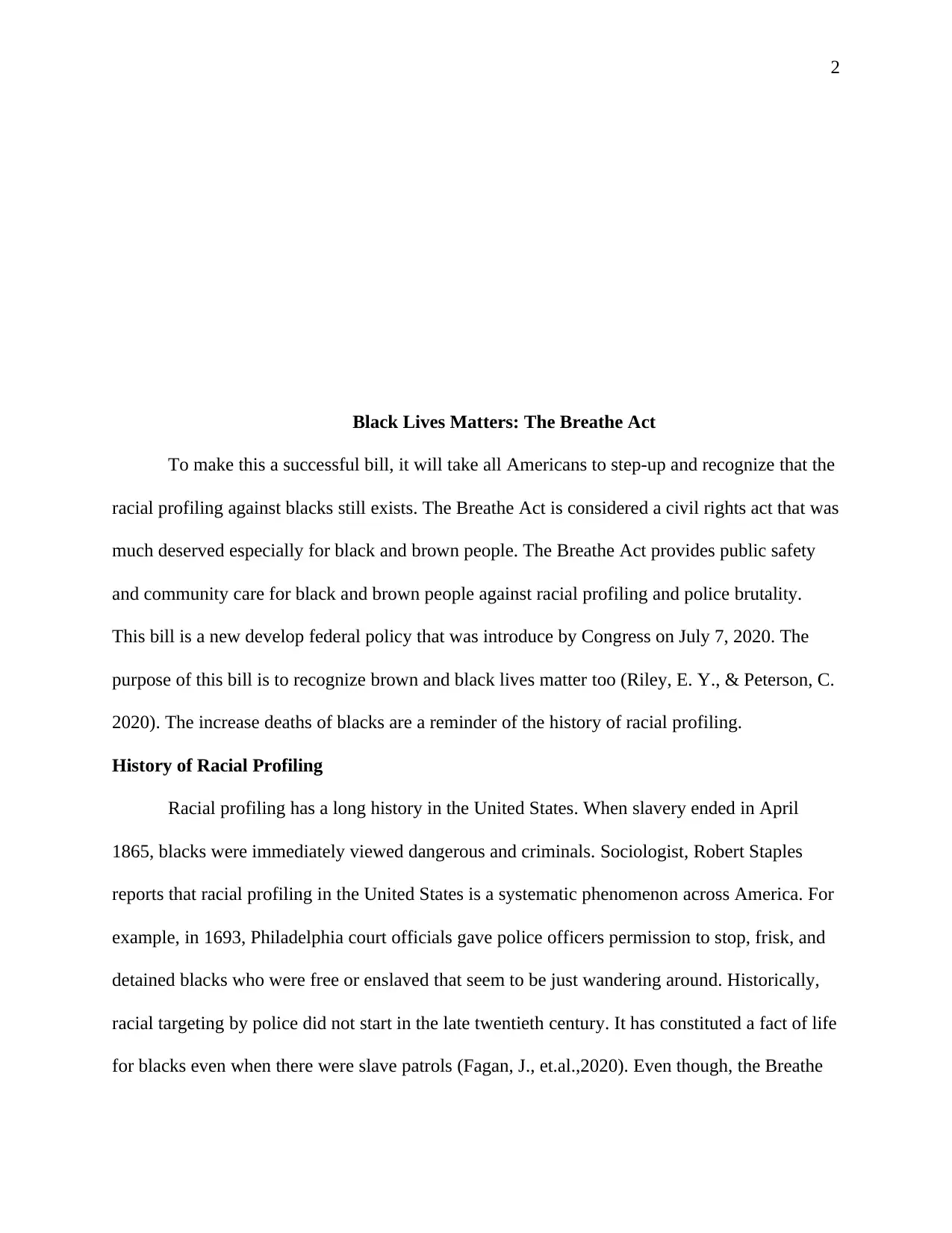
2
Black Lives Matters: The Breathe Act
To make this a successful bill, it will take all Americans to step-up and recognize that the
racial profiling against blacks still exists. The Breathe Act is considered a civil rights act that was
much deserved especially for black and brown people. The Breathe Act provides public safety
and community care for black and brown people against racial profiling and police brutality.
This bill is a new develop federal policy that was introduce by Congress on July 7, 2020. The
purpose of this bill is to recognize brown and black lives matter too (Riley, E. Y., & Peterson, C.
2020). The increase deaths of blacks are a reminder of the history of racial profiling.
History of Racial Profiling
Racial profiling has a long history in the United States. When slavery ended in April
1865, blacks were immediately viewed dangerous and criminals. Sociologist, Robert Staples
reports that racial profiling in the United States is a systematic phenomenon across America. For
example, in 1693, Philadelphia court officials gave police officers permission to stop, frisk, and
detained blacks who were free or enslaved that seem to be just wandering around. Historically,
racial targeting by police did not start in the late twentieth century. It has constituted a fact of life
for blacks even when there were slave patrols (Fagan, J., et.al.,2020). Even though, the Breathe
Black Lives Matters: The Breathe Act
To make this a successful bill, it will take all Americans to step-up and recognize that the
racial profiling against blacks still exists. The Breathe Act is considered a civil rights act that was
much deserved especially for black and brown people. The Breathe Act provides public safety
and community care for black and brown people against racial profiling and police brutality.
This bill is a new develop federal policy that was introduce by Congress on July 7, 2020. The
purpose of this bill is to recognize brown and black lives matter too (Riley, E. Y., & Peterson, C.
2020). The increase deaths of blacks are a reminder of the history of racial profiling.
History of Racial Profiling
Racial profiling has a long history in the United States. When slavery ended in April
1865, blacks were immediately viewed dangerous and criminals. Sociologist, Robert Staples
reports that racial profiling in the United States is a systematic phenomenon across America. For
example, in 1693, Philadelphia court officials gave police officers permission to stop, frisk, and
detained blacks who were free or enslaved that seem to be just wandering around. Historically,
racial targeting by police did not start in the late twentieth century. It has constituted a fact of life
for blacks even when there were slave patrols (Fagan, J., et.al.,2020). Even though, the Breathe
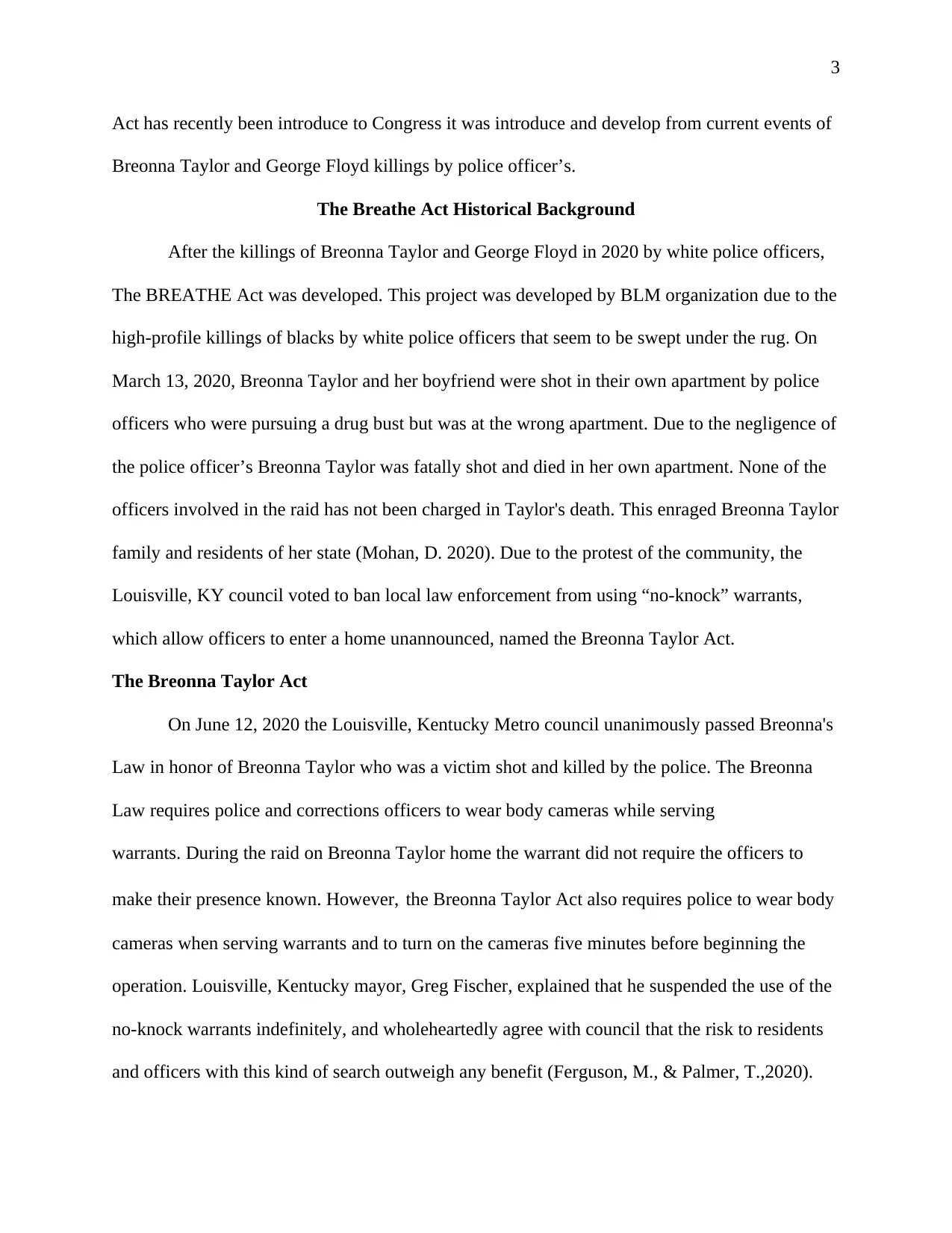
3
Act has recently been introduce to Congress it was introduce and develop from current events of
Breonna Taylor and George Floyd killings by police officer’s.
The Breathe Act Historical Background
After the killings of Breonna Taylor and George Floyd in 2020 by white police officers,
The BREATHE Act was developed. This project was developed by BLM organization due to the
high-profile killings of blacks by white police officers that seem to be swept under the rug. On
March 13, 2020, Breonna Taylor and her boyfriend were shot in their own apartment by police
officers who were pursuing a drug bust but was at the wrong apartment. Due to the negligence of
the police officer’s Breonna Taylor was fatally shot and died in her own apartment. None of the
officers involved in the raid has not been charged in Taylor's death. This enraged Breonna Taylor
family and residents of her state (Mohan, D. 2020). Due to the protest of the community, the
Louisville, KY council voted to ban local law enforcement from using “no-knock” warrants,
which allow officers to enter a home unannounced, named the Breonna Taylor Act.
The Breonna Taylor Act
On June 12, 2020 the Louisville, Kentucky Metro council unanimously passed Breonna's
Law in honor of Breonna Taylor who was a victim shot and killed by the police. The Breonna
Law requires police and corrections officers to wear body cameras while serving
warrants. During the raid on Breonna Taylor home the warrant did not require the officers to
make their presence known. However, the Breonna Taylor Act also requires police to wear body
cameras when serving warrants and to turn on the cameras five minutes before beginning the
operation. Louisville, Kentucky mayor, Greg Fischer, explained that he suspended the use of the
no-knock warrants indefinitely, and wholeheartedly agree with council that the risk to residents
and officers with this kind of search outweigh any benefit (Ferguson, M., & Palmer, T.,2020).
Act has recently been introduce to Congress it was introduce and develop from current events of
Breonna Taylor and George Floyd killings by police officer’s.
The Breathe Act Historical Background
After the killings of Breonna Taylor and George Floyd in 2020 by white police officers,
The BREATHE Act was developed. This project was developed by BLM organization due to the
high-profile killings of blacks by white police officers that seem to be swept under the rug. On
March 13, 2020, Breonna Taylor and her boyfriend were shot in their own apartment by police
officers who were pursuing a drug bust but was at the wrong apartment. Due to the negligence of
the police officer’s Breonna Taylor was fatally shot and died in her own apartment. None of the
officers involved in the raid has not been charged in Taylor's death. This enraged Breonna Taylor
family and residents of her state (Mohan, D. 2020). Due to the protest of the community, the
Louisville, KY council voted to ban local law enforcement from using “no-knock” warrants,
which allow officers to enter a home unannounced, named the Breonna Taylor Act.
The Breonna Taylor Act
On June 12, 2020 the Louisville, Kentucky Metro council unanimously passed Breonna's
Law in honor of Breonna Taylor who was a victim shot and killed by the police. The Breonna
Law requires police and corrections officers to wear body cameras while serving
warrants. During the raid on Breonna Taylor home the warrant did not require the officers to
make their presence known. However, the Breonna Taylor Act also requires police to wear body
cameras when serving warrants and to turn on the cameras five minutes before beginning the
operation. Louisville, Kentucky mayor, Greg Fischer, explained that he suspended the use of the
no-knock warrants indefinitely, and wholeheartedly agree with council that the risk to residents
and officers with this kind of search outweigh any benefit (Ferguson, M., & Palmer, T.,2020).
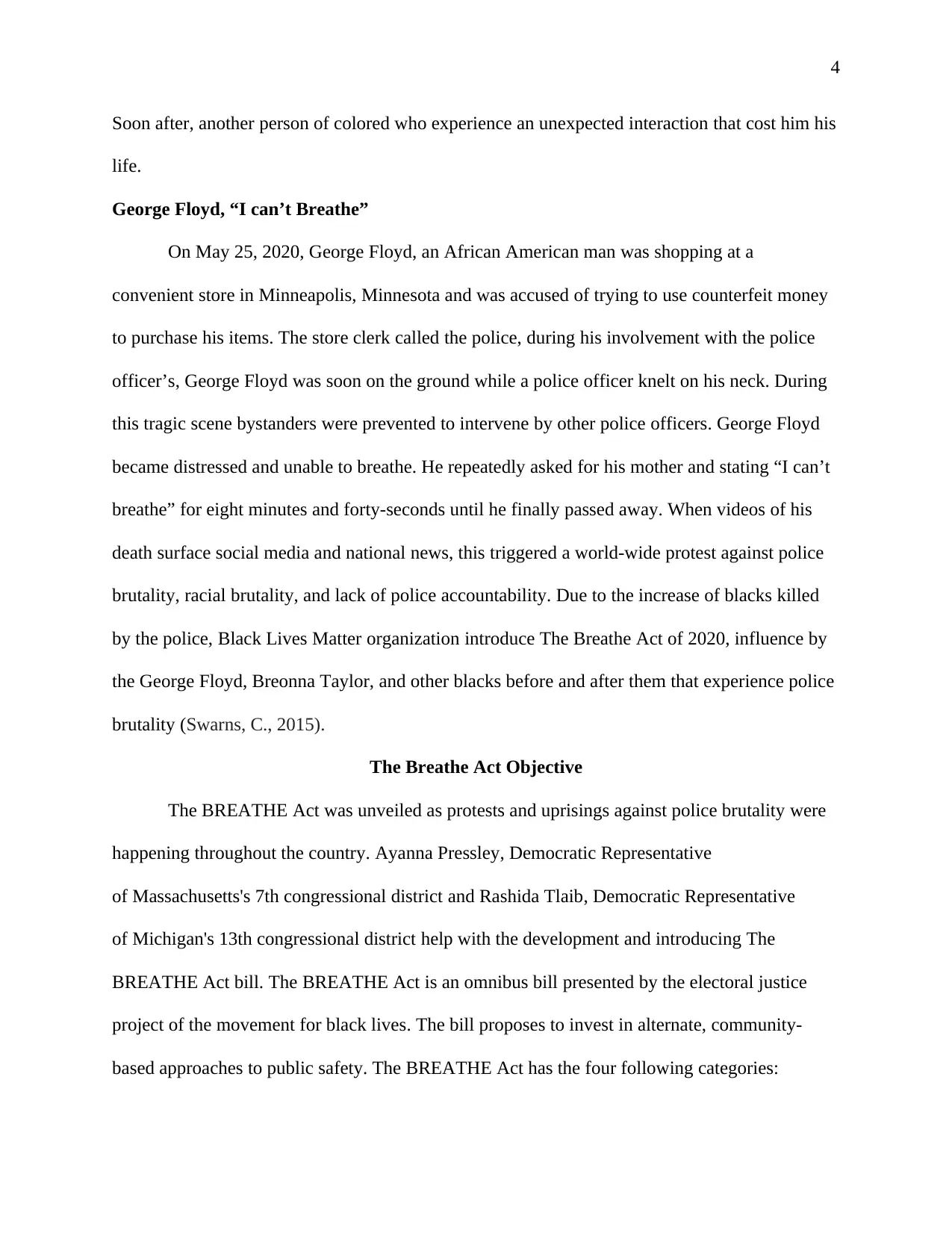
4
Soon after, another person of colored who experience an unexpected interaction that cost him his
life.
George Floyd, “I can’t Breathe”
On May 25, 2020, George Floyd, an African American man was shopping at a
convenient store in Minneapolis, Minnesota and was accused of trying to use counterfeit money
to purchase his items. The store clerk called the police, during his involvement with the police
officer’s, George Floyd was soon on the ground while a police officer knelt on his neck. During
this tragic scene bystanders were prevented to intervene by other police officers. George Floyd
became distressed and unable to breathe. He repeatedly asked for his mother and stating “I can’t
breathe” for eight minutes and forty-seconds until he finally passed away. When videos of his
death surface social media and national news, this triggered a world-wide protest against police
brutality, racial brutality, and lack of police accountability. Due to the increase of blacks killed
by the police, Black Lives Matter organization introduce The Breathe Act of 2020, influence by
the George Floyd, Breonna Taylor, and other blacks before and after them that experience police
brutality (Swarns, C., 2015).
The Breathe Act Objective
The BREATHE Act was unveiled as protests and uprisings against police brutality were
happening throughout the country. Ayanna Pressley, Democratic Representative
of Massachusetts's 7th congressional district and Rashida Tlaib, Democratic Representative
of Michigan's 13th congressional district help with the development and introducing The
BREATHE Act bill. The BREATHE Act is an omnibus bill presented by the electoral justice
project of the movement for black lives. The bill proposes to invest in alternate, community-
based approaches to public safety. The BREATHE Act has the four following categories:
Soon after, another person of colored who experience an unexpected interaction that cost him his
life.
George Floyd, “I can’t Breathe”
On May 25, 2020, George Floyd, an African American man was shopping at a
convenient store in Minneapolis, Minnesota and was accused of trying to use counterfeit money
to purchase his items. The store clerk called the police, during his involvement with the police
officer’s, George Floyd was soon on the ground while a police officer knelt on his neck. During
this tragic scene bystanders were prevented to intervene by other police officers. George Floyd
became distressed and unable to breathe. He repeatedly asked for his mother and stating “I can’t
breathe” for eight minutes and forty-seconds until he finally passed away. When videos of his
death surface social media and national news, this triggered a world-wide protest against police
brutality, racial brutality, and lack of police accountability. Due to the increase of blacks killed
by the police, Black Lives Matter organization introduce The Breathe Act of 2020, influence by
the George Floyd, Breonna Taylor, and other blacks before and after them that experience police
brutality (Swarns, C., 2015).
The Breathe Act Objective
The BREATHE Act was unveiled as protests and uprisings against police brutality were
happening throughout the country. Ayanna Pressley, Democratic Representative
of Massachusetts's 7th congressional district and Rashida Tlaib, Democratic Representative
of Michigan's 13th congressional district help with the development and introducing The
BREATHE Act bill. The BREATHE Act is an omnibus bill presented by the electoral justice
project of the movement for black lives. The bill proposes to invest in alternate, community-
based approaches to public safety. The BREATHE Act has the four following categories:
Secure Best Marks with AI Grader
Need help grading? Try our AI Grader for instant feedback on your assignments.
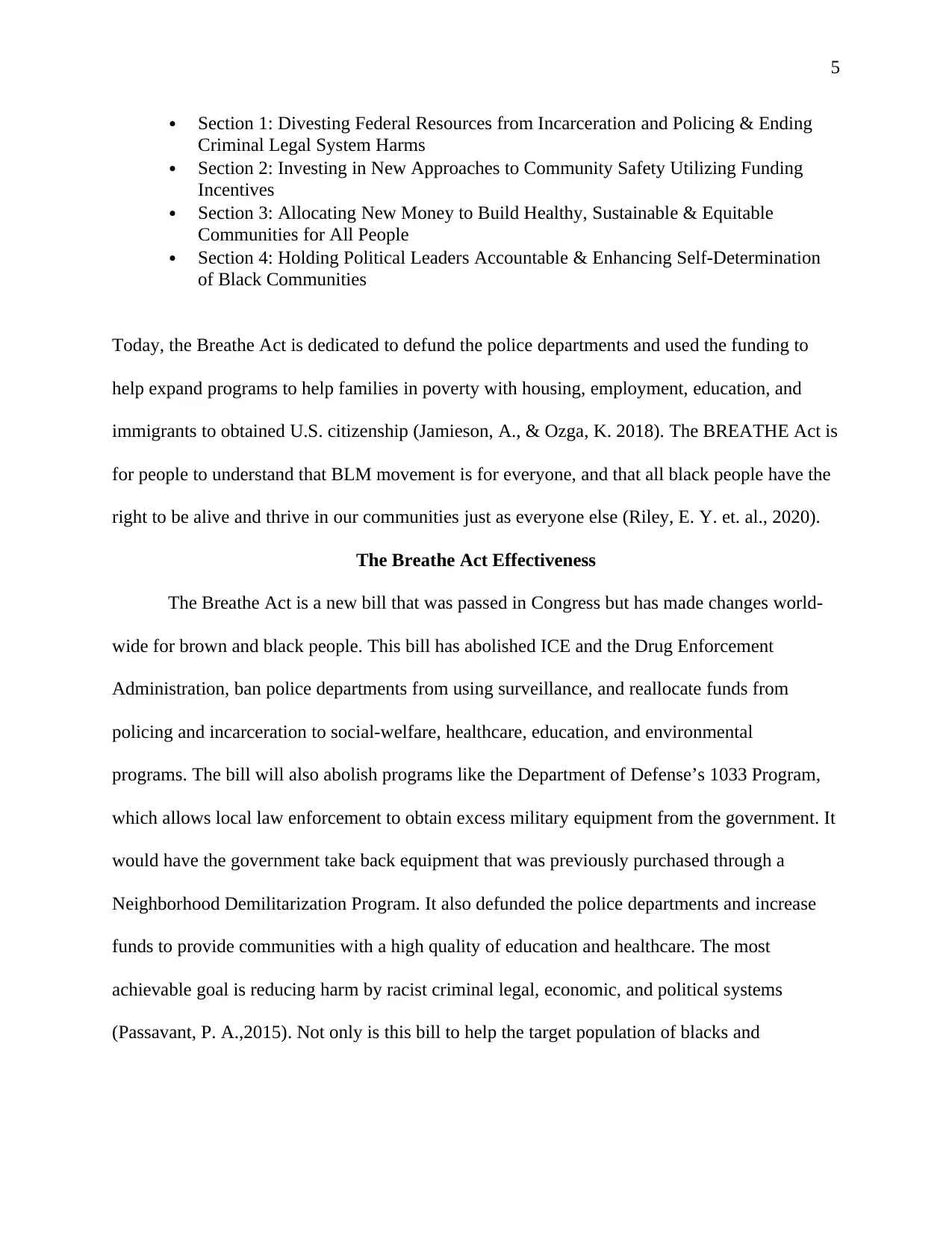
5
Section 1: Divesting Federal Resources from Incarceration and Policing & Ending
Criminal Legal System Harms
Section 2: Investing in New Approaches to Community Safety Utilizing Funding
Incentives
Section 3: Allocating New Money to Build Healthy, Sustainable & Equitable
Communities for All People
Section 4: Holding Political Leaders Accountable & Enhancing Self-Determination
of Black Communities
Today, the Breathe Act is dedicated to defund the police departments and used the funding to
help expand programs to help families in poverty with housing, employment, education, and
immigrants to obtained U.S. citizenship (Jamieson, A., & Ozga, K. 2018). The BREATHE Act is
for people to understand that BLM movement is for everyone, and that all black people have the
right to be alive and thrive in our communities just as everyone else (Riley, E. Y. et. al., 2020).
The Breathe Act Effectiveness
The Breathe Act is a new bill that was passed in Congress but has made changes world-
wide for brown and black people. This bill has abolished ICE and the Drug Enforcement
Administration, ban police departments from using surveillance, and reallocate funds from
policing and incarceration to social-welfare, healthcare, education, and environmental
programs. The bill will also abolish programs like the Department of Defense’s 1033 Program,
which allows local law enforcement to obtain excess military equipment from the government. It
would have the government take back equipment that was previously purchased through a
Neighborhood Demilitarization Program. It also defunded the police departments and increase
funds to provide communities with a high quality of education and healthcare. The most
achievable goal is reducing harm by racist criminal legal, economic, and political systems
(Passavant, P. A.,2015). Not only is this bill to help the target population of blacks and
Section 1: Divesting Federal Resources from Incarceration and Policing & Ending
Criminal Legal System Harms
Section 2: Investing in New Approaches to Community Safety Utilizing Funding
Incentives
Section 3: Allocating New Money to Build Healthy, Sustainable & Equitable
Communities for All People
Section 4: Holding Political Leaders Accountable & Enhancing Self-Determination
of Black Communities
Today, the Breathe Act is dedicated to defund the police departments and used the funding to
help expand programs to help families in poverty with housing, employment, education, and
immigrants to obtained U.S. citizenship (Jamieson, A., & Ozga, K. 2018). The BREATHE Act is
for people to understand that BLM movement is for everyone, and that all black people have the
right to be alive and thrive in our communities just as everyone else (Riley, E. Y. et. al., 2020).
The Breathe Act Effectiveness
The Breathe Act is a new bill that was passed in Congress but has made changes world-
wide for brown and black people. This bill has abolished ICE and the Drug Enforcement
Administration, ban police departments from using surveillance, and reallocate funds from
policing and incarceration to social-welfare, healthcare, education, and environmental
programs. The bill will also abolish programs like the Department of Defense’s 1033 Program,
which allows local law enforcement to obtain excess military equipment from the government. It
would have the government take back equipment that was previously purchased through a
Neighborhood Demilitarization Program. It also defunded the police departments and increase
funds to provide communities with a high quality of education and healthcare. The most
achievable goal is reducing harm by racist criminal legal, economic, and political systems
(Passavant, P. A.,2015). Not only is this bill to help the target population of blacks and
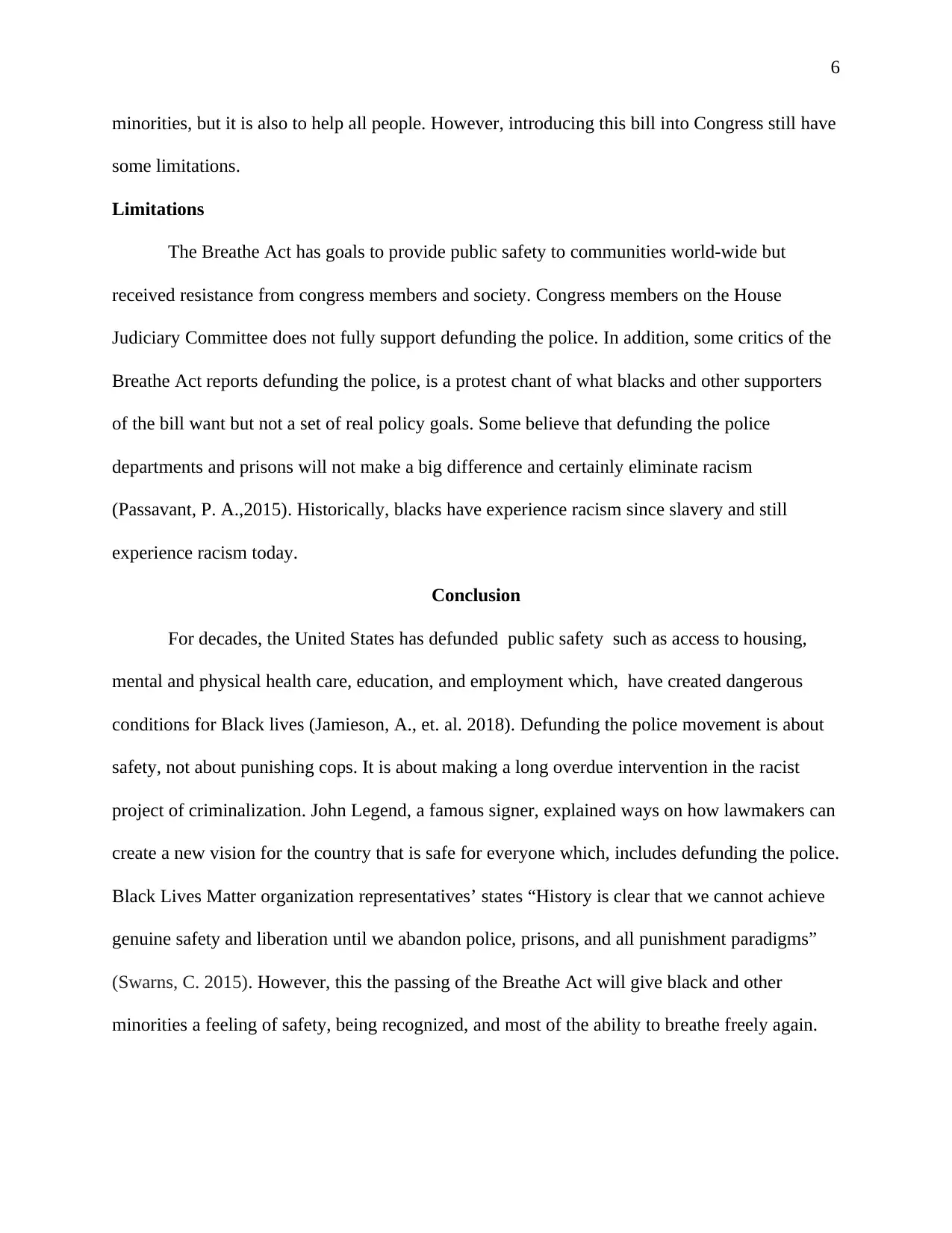
6
minorities, but it is also to help all people. However, introducing this bill into Congress still have
some limitations.
Limitations
The Breathe Act has goals to provide public safety to communities world-wide but
received resistance from congress members and society. Congress members on the House
Judiciary Committee does not fully support defunding the police. In addition, some critics of the
Breathe Act reports defunding the police, is a protest chant of what blacks and other supporters
of the bill want but not a set of real policy goals. Some believe that defunding the police
departments and prisons will not make a big difference and certainly eliminate racism
(Passavant, P. A.,2015). Historically, blacks have experience racism since slavery and still
experience racism today.
Conclusion
For decades, the United States has defunded public safety such as access to housing,
mental and physical health care, education, and employment which, have created dangerous
conditions for Black lives (Jamieson, A., et. al. 2018). Defunding the police movement is about
safety, not about punishing cops. It is about making a long overdue intervention in the racist
project of criminalization. John Legend, a famous signer, explained ways on how lawmakers can
create a new vision for the country that is safe for everyone which, includes defunding the police.
Black Lives Matter organization representatives’ states “History is clear that we cannot achieve
genuine safety and liberation until we abandon police, prisons, and all punishment paradigms”
(Swarns, C. 2015). However, this the passing of the Breathe Act will give black and other
minorities a feeling of safety, being recognized, and most of the ability to breathe freely again.
minorities, but it is also to help all people. However, introducing this bill into Congress still have
some limitations.
Limitations
The Breathe Act has goals to provide public safety to communities world-wide but
received resistance from congress members and society. Congress members on the House
Judiciary Committee does not fully support defunding the police. In addition, some critics of the
Breathe Act reports defunding the police, is a protest chant of what blacks and other supporters
of the bill want but not a set of real policy goals. Some believe that defunding the police
departments and prisons will not make a big difference and certainly eliminate racism
(Passavant, P. A.,2015). Historically, blacks have experience racism since slavery and still
experience racism today.
Conclusion
For decades, the United States has defunded public safety such as access to housing,
mental and physical health care, education, and employment which, have created dangerous
conditions for Black lives (Jamieson, A., et. al. 2018). Defunding the police movement is about
safety, not about punishing cops. It is about making a long overdue intervention in the racist
project of criminalization. John Legend, a famous signer, explained ways on how lawmakers can
create a new vision for the country that is safe for everyone which, includes defunding the police.
Black Lives Matter organization representatives’ states “History is clear that we cannot achieve
genuine safety and liberation until we abandon police, prisons, and all punishment paradigms”
(Swarns, C. 2015). However, this the passing of the Breathe Act will give black and other
minorities a feeling of safety, being recognized, and most of the ability to breathe freely again.
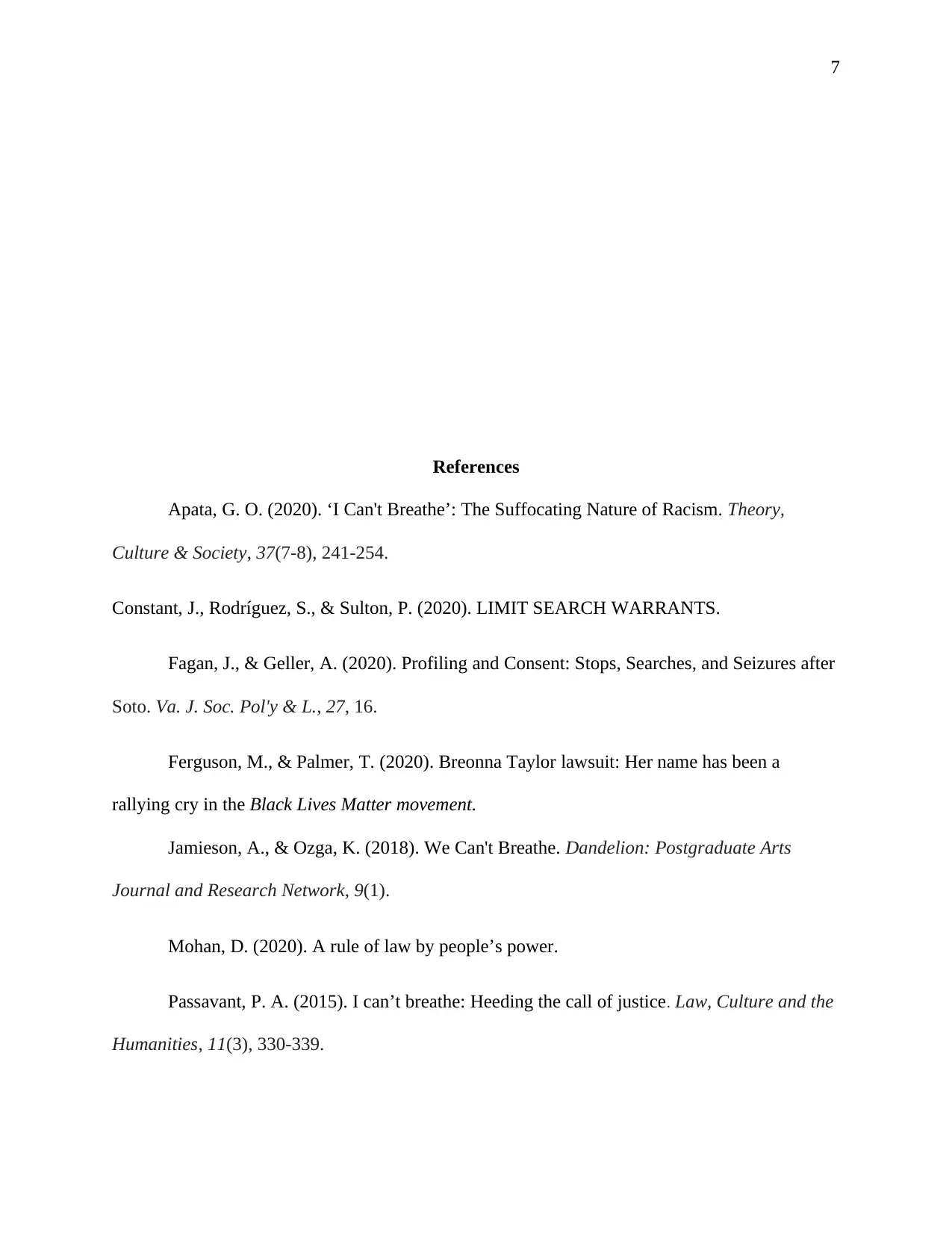
7
References
Apata, G. O. (2020). ‘I Can't Breathe’: The Suffocating Nature of Racism. Theory,
Culture & Society, 37(7-8), 241-254.
Constant, J., Rodríguez, S., & Sulton, P. (2020). LIMIT SEARCH WARRANTS.
Fagan, J., & Geller, A. (2020). Profiling and Consent: Stops, Searches, and Seizures after
Soto. Va. J. Soc. Pol'y & L., 27, 16.
Ferguson, M., & Palmer, T. (2020). Breonna Taylor lawsuit: Her name has been a
rallying cry in the Black Lives Matter movement.
Jamieson, A., & Ozga, K. (2018). We Can't Breathe. Dandelion: Postgraduate Arts
Journal and Research Network, 9(1).
Mohan, D. (2020). A rule of law by people’s power.
Passavant, P. A. (2015). I can’t breathe: Heeding the call of justice. Law, Culture and the
Humanities, 11(3), 330-339.
References
Apata, G. O. (2020). ‘I Can't Breathe’: The Suffocating Nature of Racism. Theory,
Culture & Society, 37(7-8), 241-254.
Constant, J., Rodríguez, S., & Sulton, P. (2020). LIMIT SEARCH WARRANTS.
Fagan, J., & Geller, A. (2020). Profiling and Consent: Stops, Searches, and Seizures after
Soto. Va. J. Soc. Pol'y & L., 27, 16.
Ferguson, M., & Palmer, T. (2020). Breonna Taylor lawsuit: Her name has been a
rallying cry in the Black Lives Matter movement.
Jamieson, A., & Ozga, K. (2018). We Can't Breathe. Dandelion: Postgraduate Arts
Journal and Research Network, 9(1).
Mohan, D. (2020). A rule of law by people’s power.
Passavant, P. A. (2015). I can’t breathe: Heeding the call of justice. Law, Culture and the
Humanities, 11(3), 330-339.
Paraphrase This Document
Need a fresh take? Get an instant paraphrase of this document with our AI Paraphraser
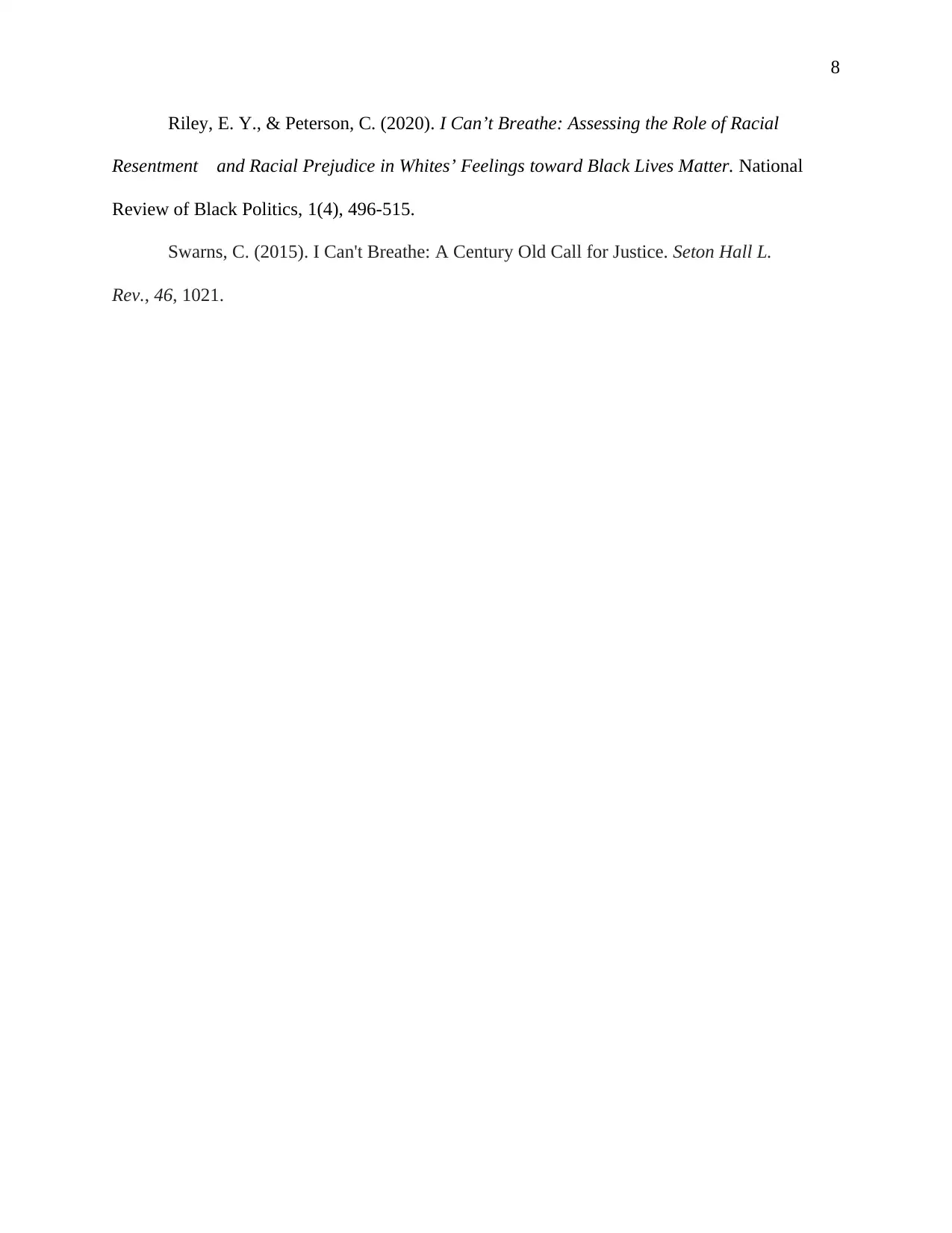
8
Riley, E. Y., & Peterson, C. (2020). I Can’t Breathe: Assessing the Role of Racial
Resentment and Racial Prejudice in Whites’ Feelings toward Black Lives Matter. National
Review of Black Politics, 1(4), 496-515.
Swarns, C. (2015). I Can't Breathe: A Century Old Call for Justice. Seton Hall L.
Rev., 46, 1021.
Riley, E. Y., & Peterson, C. (2020). I Can’t Breathe: Assessing the Role of Racial
Resentment and Racial Prejudice in Whites’ Feelings toward Black Lives Matter. National
Review of Black Politics, 1(4), 496-515.
Swarns, C. (2015). I Can't Breathe: A Century Old Call for Justice. Seton Hall L.
Rev., 46, 1021.
1 out of 8
Your All-in-One AI-Powered Toolkit for Academic Success.
+13062052269
info@desklib.com
Available 24*7 on WhatsApp / Email
![[object Object]](/_next/static/media/star-bottom.7253800d.svg)
Unlock your academic potential
© 2024 | Zucol Services PVT LTD | All rights reserved.
